| |||||||||||||||||||||||||||||||||
| Reasons > Borrowing > First |
|
Reasons >
|
Choices | Borrowing | Different | The Bible is true | Faith |
| First | Independently | From Judaism | Xerox copying |
| FIRST
—Them varmint Pagans done stole from us |
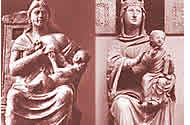
|
The majority of evidence
for Near Eastern dying and rising deities occurs in Greek and Latin
texts of late antiquity, usually post-Christian in date. How
come the Pagans, who were busy killing Christians on account of their
religion, thought it was a good idea to copy the religion of the people
they were killing for their religion?" |
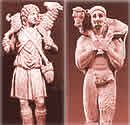 |
OK, so here's where we are. The ancient evidence under the Facts bar has proven lots of Pagan-Christian similarities. In this Reasons part of POCM we're going through the possible explanations of экскурсии по Москве на автобусе those similarities, looking at which explanations are comprehensive and consistent. And which aren't. We're about to talk about Defense of the Faith #3: Christian and Pagan ideas are similar, but Christian ideas came first—Them varmint Pagans done stole from us! We'll see that there are a handful of Pagan-Christian similarities for which this defense makes sense and a few more for which it can't be disproven. But for the vast majority of Pagan-Christian similarities, there is no doubt whatsoever that Pagan religions got there first. Which 1) blunts the effectiveness of the TVPDSFU as a defense of the uniqueness of Christianity, and 2) means using TVPDSFU raises consistency problems for apologists out to deny borrowing. |
|
How the Them Varmint Pagans Done Stole From Us defense got started
Which means, for most of ancient history we have only the vaguest record of what the mystery religions taught. Of course once Christianity began and only-our-God-is-real Christians began attacking Pagan faith, ancient Christian writers had no problem spilling heathen beans. In a few instances the only ancient sources detailing the rites, rituals or theologies of secret Pagan religions are Christian. |
*"Believers"
isn't a perfect term here. "Initiates" maybe captures
it better. |
|||
|
Which means our only evidence for those theologies dates from after
the founding of Christianity Doctor of Divinity Nock's defense of the faith is this: maybe the centuries-old Pagan religions developed their sacraments only in the second century. Or the third century. Maybe the fourth. Whenever the first Christian description of them was recorded. Which is a bigger deal than you might think, because one of those theologies is supposedly the resurrection of the dead godman. |
| Believers
in their own words What I hope you notice is neither author talks about how his version of the 'Paganism is late' reasoning fits into a larger theory of Christian origins. The don't ask, "Well OK, the dates being uncertain and all, how do I know who borrowed from whom?", or "How come the Pagans, who were busy killing Christians on account of their religion, thought it was a good idea to copy the religion of the people they were killing for their religion?", or any stuff like that. They just toss up the Them varmint Pagans done stole from us theory and quick like a bunny scamper off to other stuff. |
Believers in their own words |
|
How to explain this? Professor Smith imagines maybe the Christians
alive back then, you know those Christian people living in a pagan
culture, some of whom had converted to Christianity from Paganism,
maybe they didn't know as much about Adonis-ism as some people today—associate
professors for example. Maybe those Christians back then—all
of them—just imagined Adonis rose
from the dead. |
Considerably later, the Christian
writers Origen and Jerome, commenting on Ezekiel
8:14, and Cyril of Alexandria and Procopius
of Gaza, commenting on Isaiah 18:1, clearly
report joyous festivities on the third day to celebrate Adonis (identified
with Tammuz) having been "raised
from the dead." Whether this represents an interpretatio
Christians or whether late third- and fourth century forms of the
Adonis cult themselves developed a dying and rising mythology (possibility
in imitation of the Christian myth) cannot be determined. |
The possibilities, according to Professor Smith's analysis,
are that: Which possibility is correct? Professor Smith's analysis doesn't go into that. He doesn't seem to care. |
Hey wait ... now that I think about it, is it possible—not certain, not likely, not probable, just possible—is it possible all these multiple accounts from multiple independent sources simply mean what they say, that Adonis did rise from the dead? Sorry. That's the one possibility Professor Smith's analysis doesn't consider. It's as if what he's really after is not what happened, it's as if he's just after a reason not to see Christian borrowing.
|
By the way |
Let me mention how truly stunning it is that Dr. Smith's Dying and Rising Gods, the most famous analysis of ancient dying and rising gods, completely ignores the death and resurrection of Jesus -- the one ancient God everyone agrees did die and rise. Does finding one gold nugget in a stream make it more likely or less likely all those other shiny things in the water are also gold? |
|
|
| Remember, I'm not telling you about Dr. Smith because I think his analysis is weak. I'm showing you what he wrote because on the subject of dying and rising gods Dr. Smith is the most famous, most admired, most cited, most quoted anti-dying-and-rising-gods scholar there is. And this encyclopedia article is the most famous, most admired, most cited, most quoted anti-dying and rising god scholarship going. And it ignores exactly the possibility it pretends to analyze! |
Big puzzle, small pieces God, soul, sin, heaven, hell, demons, miracles, godmen, sons of God, savior Gods, salvation, eternal life, sacred meals shared with the god, mystery religions with initiations by baptism—all those things are unequivocally older than Christianity by centuries. |
|
|||||||
|
"Scholarship" reality
check
Scholars who put up Them varmint Pagans done stole
from us—we'll read the words of two of the theory's most
famous proponents in just a minute, in the green boxes—don't support
their claims with the results of their research and study and analysis
and reasoning. They don't pretend to have done research and
study about the idea. It's enough for them that the idea is,
in the absence of any specific facts (their theory works better if they
choose not to look), conceivable. It is conceivable. It fits their general
purpose of defending the faith. They put it up and move on.
Alright then, what's on this page?
|
| IntroductionBelievers in their own wordsReasons Vagueness as strategy Implications Who was first Do old religions copy from new religions? Similarities at issue |
| IntroductionBelievers in their own wordsReasons Vagueness as strategy Implications Who was first Do old religions copy from new religions? Similarities at issue |
Reasons |
| Vagueness
as strategy Did you catch that? They didn't give any evidence. They don't have any evidence. TVPDSFU theorists don't have any evidence of Paganism borrowing from Christianity. |
|
Remember, for the overwhelming majority of Christian - Pagan similarities
Paganism undisputedly got there first, generations before Jesus. That
means that for all those theologies and sacraments, Pagan But with only a few specific points at issue, TVPDSFU stays vague. TVPDSFU theorists don't give you specific facts that support any of the few vaguely possible specific borrowings. They don't give you facts showing that Mithras' taurobolium was borrowed from Christian baptism. They don't give you facts showing that Adonis' resurrection was borrowed from Jesus'. TVPDSFU doesn't give specifics. its proponents, in their strongest writing, just talk about Pagan borrowing in a general way. |
|
Don't get me wrong. Doctor of Divinity Nock was a plenty smart scholar of ancient religions. His famous book—Conversion— all about how ancient religions, Pagan and Christian, spread, includes plenty about how Pagan religions copied from each other. But, according to Doctor of Divinity Nock, real conversion was possible only to Christianity. Pagan religions weren't high class enough. And in Co version Doctor of Divinity Nock's rules about what evidence indicates borrowing differ from Pagan and Christian. |
This vagueness helps the TVPDSFU theory several ways
|
| IntroductionBelievers in their own wordsReasons Vagueness as strategy Implications Who was first Do old religions copy from new religions? Similarities at issue |
Implications |
So they were similar? One of believers' other favorite defenses to counter the evidence of Christian borrowing is to say that Christianity was way different from Paganism. Our baptism, that was completely different from their baptism. Our Washed in the Blood of the Lamb is completely different from their Washed (literally, in the sacred rite of the cribolium) in the Blood of the Lamb Flip.
It fit. That's a big deal. To see how close religions must be to each other to borrow core sacraments, try some other swaps. Try fitting the Hindu idea of salvation and redemption by way of gradual perfection of the soul through many reincarnations, try fitting that into Christian theology. You can't do it. It doesn't fit. Christianity and Hinduism are deeply different. Try fitting the Aztec idea of world and tribal salvation by way of cutting up little children and eating their parts into Christian theology. You can't do it. It doesn't fit. Christianity and Quetzalcoatl-ism are deeply different. Back to the Mithraic blood baptism. According to the TVPDSFU theory, Christian salvation and Christian baptism fit right in with whatever ideas about God, sin, soul, prayer, eternal life, redemption, etc., Mithras-ism already had. Mithras-ism and Christianity were similar. Flop.
|
|
That's it. No Pagan ever wrote, "We thieved baptism from those nasty atheist Christians we were burning at the time." No ancient Christian ever wrote, "Them varmint Pagans done stole from us." When believers make the TVPDSFU claim, all Doctor of Divinity Nock's careful analysis, all his stuff about being sure the ideas have precisely similar characters, and at exactly the right time and in exactly the right city and with exactly the right intensity, all that stuff doesn't apply here. The way the TVPDSFU theory works is, the mere fact that Christian baptism dates before the first mention of the Mithraic taurobolium blood baptism means that the taurobolium was borrowed from Christianity . They're similar (using the new standard), the second one copied. OK, fine. Now let's apply that they're similar, the second one copied reasoning to other elements of ancient religions. Paganism and Christianity both had: godmen, Sons of God, miracles, prayer, salvation, rising and dying Gods, sacred meals shared with the God, initiations, virgin births, prophesies, eternal life, etc. etc. And Paganism had all those things first. So Christianity borrowed all those things, right? Two problems.
TVPDSFU is a trick, a way for believers to get to the answer they're after. We can still be friends. |
| IntroductionBelievers in their own wordsReasons Vagueness as strategy Implications Who was first Do old religions copy from new religions? Similarities at issue |
|
Lets talk about those details. |
Who
was first? |
1.
Un-ignoring the evidence. |
|
Oops. |
In the case of Adonis' resurrection the Christian who, according to the TVPDSFU theory, didn't understand Paganism was famous, even among Pagans, for his Pagan learning. Man, I wish I was getting paid by the comma for that sentence. When it came to things Pagan, Origen didn't know what he was talking about—in fact all those Christians recording Pagan beliefs didn't know what they were talking about. . . is a trick, a way to get to the answer anti-borrowing "scholars" are after. |

2. Pagan
sacred secrets revealed only by Christians Till
the lights came on, the room was dark. Quick, turn the lights on. >> Now you see the sofa. Was the sofa there before? TVPDSFU says it wasn't. Here's what I mean. |
| Mystery religions' sacraments were sacred secrets. Secrets. Disclosing them to the uninitiated was illegal. Against the law. More than that, disclosing sacred secrets was profane—like masturbating in public. Actually, Diogenes the Cynic was famous for the touching himself in public thing, so: revealing sacred secrets was worse than masturbating in public. People didn't do it.
Mostly we don't know what the mysteries' rituals and sacraments
were. Where we do know, the evidence
is from Christian sources. And, get this, all the Christian evidence dates from after the founding of Christianity! Till the lights came on, the room was dark. |
O Holy
rites of a similar kind were in use also among the Epidaurians,
and likewise another sort of holy rites, whereof
it is not lawful to speak. |
| Till the lights came on, the room was dark. From which believers come up with the theory that maybe the centuries-old Pagan religions developed their sacraments only in the second century. Or the third century. Maybe the fourth. Whenever the first Christian description of them was recorded.
|
3.
Many Christianities Maybe. Maybe not. I can't give you all the evidence here, (POCM talks about the great variety of early Christianities at Triumph > After Jesus: Scholarship) but basically early on there were lots of Christianities, and lots of Christian theologies. |
|
For example, here's the fourth century orthodox church historian
Eusebius describing the Ebionites, a Christian sect
that believed: Obviously Paganism didn't borrow the idea of virgin born Gods from that version of Christianity. |
3.27 (1) The spirit of wickedness, however, being unable to shake some
in their love of Christ and yet finding them susceptible of his impressions
in other respects, brought them over to his purposes. These were properly
called Ebionites
by the ancients, as those who cherished low
and mean opinions of Christ. (2) They
considered him a plain and
common man and justified only by his advances in virtue and
that he was born of the Virgin Mary by natural generation.
With them the observance of
the law was altogether necessary,
as if they could not be saved only by faith in Christ and a corresponding
life. |
Does that seem like a trivial point to you? It shouldn't. One of the most powerful and widespread kinds of early Christianity was gnosticism. The gnostics believed Jesus saved not by his dying and resurrection. The gnostics believed Jesus saved by the sacred wisdom he taught. The gnostic Gospel of Thomas never mentions Jesus saving death. If the Adonis-ists borrowed Adonis' resurrection, they didn't borrow it from the gnostics. As far as Pagan borrowing goes, the question is, did the Christianities the Pagans contacted in the years before Christians first mentioned the Pagan beliefs—Adonis' resurrection, etc.—did those Christianities have the beliefs borrowing scholars theorize the Pagans borrowed. I don't know. As far as I know the analysis has not been done. I do know there is good scholarship demonstrating that in many places around the ancient Mediterranean the first Christianities were not orthodox Christianities with all the legends and theologies we're used to. |
|
There is, for example, Dr. Bauer's: : Then in the 1930s this German guy named Walter Bauer decided to actually look at the evidence. Imagine! What he discovered was that pretty much everywhere he looked—Syria, Palestine, Egypt, etc.—the "heresies" weren't branches off any trunk, they were the original local Christianities. And they weren't small marginal sects, they were the main local Christianities. The evidence shows that all around the Mediterranean, outside Rome, the orthodox New Testament Roman Christianity was a secondary sect, a sect that became dominant only after the conversion of Constantine gave it the advantage of Roman swords. Wow. No wonder the big boys call this as a paradigm shattering book. Scholarly and technical, especially in the tedious first section of chapter one. Stick with it, because it gets fun and exciting. |
Orthodoxy
and Heresy in Earliest Christianity
|
|
|
On what schedule any of this happened, Dr. Smith's theory doesn't say. That #1 the resurrection sects were around is certainly true—Paul was part of one by 50 AD. When did the Christians become important enough to be known and copied (#3- 4)? We know from Pliny's letter to Trajan that in 117 AD Christianity was so remote and unknown that the emperor Trajan needed a background briefing just to get up to speed on the most basic facts about the new religion.
Because, of course, it didn't happen. Couldn't happened. There wasn't time. |
#5
The early Christian apologists give the opposite timing:
them varmint daemons done stole from us—magically, backwards
in time. |
| Demonic imitation In fact when early apologists mention timing, they say the opposite. They say pagan ideas came first. That bothers them. How to explain that? Here's Justin Martyr, a mid-first century
church father explaining how that worked >>
How that worked, said Justin, was the magical daemons got hold of the predictions of Yahweh's prophets, and the daemons copied Christ before he even happened. Jesus was copied by Paganism—magically, backwards in time. For example, says Justin, the daemons made Dionysus [aka Bacchus] the Son of God [Jupiter], who died and ascended to heaven. And the daemons made the God Perseus be born of a virgin and ascend to heaven—just like Jesus. Said Justin, the early Christian apologist. And Aesclapius healed the sick and raised the dead. First. By daemonic imitation.
|
But those who hand
down the myths which the poets
have made, adduce no proof to the youths who learn them; and we proceed
to demonstrate that they have been uttered by the
influence of the wicked demons, to deceive and lead astray
the human race. For having
heard it proclaimed through the prophets that the Christ was to come,
and that the ungodly among men were to be punished by fire, they
put forward many to be called sons of Jupiter, under the impression
that they would be able to produce in men the idea that the things which
were said with regard to Christ were mere marvellous tales, like the
things which were said by the poets. And these things were said
both among the Greeks and among all nations where they [the demons]
heard the prophets foretelling that Christ would specially be believed
in; but that in hearing what was said by the prophets they did not accurately
understand it, but imitated what was said of our Christ, like men who
are in error, we will make plain. The prophet Moses, then, Was, as we
have already said, older than all writers; and by him, as we have also
said before, it was thus predicted: "There shall not fail a prince
from Judah, nor a lawgiver from between his feet, until He come for
whom it is reserved; and He shall be the desire of the Gentiles, binding
His foal to the vine, washing His robe in the blood of the grape."
The devils, accordingly, when
they heard these prophetic words,
said that Bacchus was the son of Jupiter, and gave out that He
was the discoverer of the vine, and they number wine [or, the ass] among
his mysteries; and they taught that,
having been torn in pieces, He ascended into heaven. And because
in the prophecy of Moses it had not been expressly intimated whether
He who was to come was the Son of God, and whether He would, riding
on the foal, remain on earth or ascend into heaven, and because the
name of "foal" could mean either the foal of an ass or the
foal of a horse, they, not knowing whether He who was foretold would
bring the foal of an ass or of a horse as the sign of His coming, nor
whether He was the Son of God, as we said above, or of man, gave out
that Bellerophon, a man born of man, himself ascended to heaven on his
horse Pegasus. And when they heard it said by the other prophet Isaiah,
that He should be born of a virgin,
and by His own means ascend into heaven, they pretended that Perseus
was spoken of. And when they knew what was said, as has been
cited above, in the prophecies written aforetime, "Strong as a
giant to run his course," they said that Hercules was strong, and
had journeyed over the whole earth. And when, again, they learned that
it had been foretold that He should heal every sickness,
and raise the dead, they produced
Aesculapius. |
 |
| IntroductionBelievers in their own wordsReasons Vagueness as strategy Implications Who was first Do old religions copy from new religions? Similarities at issue |
| On to the next subject. Remember we've been taking about how they're similar, the second one copied applies to POCM's reasoning for Christian borrowing? TVPDSFU uses that reasoning. So does POCM. The difference is in the details. We've just looked at Who was really first. Now lets look at:
|
1.
Do old religions copy from new ones? But maybe in the ancient world water ran uphill. Maybe back then establishment religions did borrow from obscure upstart sects. Good news: this is a factual question with a factual answer. Scholarship does know a lot about how ancient religions spread, and it turns out even back in ancient times water did not flow uphill. POCM doesn't have room for all the details, which run to hundreds of pages, so let me refer you to a couple of the standard books.
Doctor of Divinity Arthur Darby Nock's Conversion; The Old and New in Religion From Alexander the Great to Augustine of Hippo (1933, with several later reprints) is about how ancient religions traveled from country to country and person to person.
|
Cumont was a famous borrowing scholar. Doctor of Divinity Nock was a celebrated defender of the faith. And here's the thing: they both agree (and give plenty primary of evidence showing) that ethnic religions spread like ethnic food: as people moved around the empire, they took their beliefs with them. Gods and myths moved from place to place as whole religions, gods and myths didn't jump from new religions to old religions. Several ancient middle eastern religions had priests who whipped, cut, even castrated themselves. One of these, the worship of Cybele and Attis, moved to Rome in 204 BC. In Rome Cybele's priests continued to whip, cut and castrate themselves. But the priests of the old Roman Gods never took up the practice. Attis died. In Rome His faithful celebrated His death. But the old Roman Gods Jupiter and Minerva, etc. never added a death and resurrection story to their mythology. In the ancient world, as in ours, old establishment religions did not drop their stuff and pick up theologies from new religions. The pope doesn't pray from the Book of Mormon. That's another reason the TVPDSFU theory is silly. |
By the way |
When you read Doctor of Divinity Nock's Conversion, I hope you'll notice that he's pretty good at giving evidence about how Pagan religions spread. But when he gets to the part about how Christianity spread, the evidence stops. That's because there is little or no evidence about how Christianity spread. Doctor of Divinity Nock is guessing what happened. And as usual his guesses are guided the beliefs he had before he started the book. Doctor of Divinity Nock believed what he believed, the scholarship was there to show how Jesus was God, not whether Jesus was God. |
|
| |
You see, for one thing, the poor devils [the Christians] have convinced themselves they're all going to be immortal and live forever, which makes most of them take death lightly and voluntarily give themselves up to it. For another, that first lawgiver of theirs persuaded them that they're all brothers the minute they deny the Greek gods (thereby breaking our law) and take to worshiping him, the crucified sophist himself, and to living their lives according to his rules. They scorn all possessions without distinction and treat them as community property; doctrines like this they accept strictly on faith. Consequently, if a professional sharper who knows how to capitalize on a situation gets among them, he makes himself a millionaire overnight, laughing up his sleeve at the simpletons. As it happened, Peregrinus was released from jail
by the governor of Syria. The governor had a penchant for philosophy
and, fully aware that Peregrinus was enough
of a lunatic to welcome a death that would give him a martyr's acclaim,
set him free without considering him worth even the customary
flogging. |
3. How is a new theology added to a complex old system? |
4. Compare /c adoption other eastern religions—adopted whole religion rather than parts of theology. |
| IntroductionBelievers in their own wordsReasons Vagueness as strategy Implications Who was first Do old religions copy from new religions? Similarities at issue |
|
Why the mess? POCM 2012 |
 |
| IntroductionBelievers in their own wordsReasons Vagueness as strategy Implications Who was first Do old religions copy from new religions? Similarities at issue |
The
evidence So what "late" evidence are we talking about? Here's a partial list:
|
Pagan mystery religions were more than a jumble of myths, they were religions of salvation that must have had a logical structure. What were the details of of their theologies? We don't know. What we do know is that mystery religions had a godman, initiations, sacred meals, rituals and prayers that combined to bring believers personal salvation. You gotta' figure that each bit fit with all the other bits to get the job done. The point, from a Pagan borrowing point of view, is how was a new sacrament like baptism fit into an already complete religion. TVPDSTU scholars never say. What the TVPDSFU theory imagines is that Paganism somehow borrowed Christianity's central sacraments and somehow dropped that one sacrament into an already working centuries-old theology. How that worked the TVPSDFU folks don't ever work out. For example, Reverend
Metzger imagines [with no evidence] that Mitras-ism borrowed it's
bull's blood baptism from Christianity. Is there any evidence of Mithraic
theology or adjusting to the new sacrament? Reverend Metzger offers
none. Did Mithraic inscriptions, or iconography or the progression of
its sacred orders change? Reverend Metzger offers no evidence they did.
Somehow, he imagines, the central sacrament of Christianity is dropped
into another religion and—besides the single inscription naming
the sacrament—there is no record of any change. |
Mithraic inscription: , Saved by the blood |
|
Taurobolium |
|
Some evidence about the rising part of dying and rising gods Adonis, Attis |
|
Attis' Hilaria—Plutarch 2d century AD |


 N the late 1800s guys like Hatch and Frazer described undeniable similarities
between Paganism and Christianity. By the 1920s Christian borrowing
was widely believed. Facts were facts. Christian believers could not
deny many deep similarities. How to defend the uniqueness of the faith?
The strategy believers lit on was to admit similarities but
deny borrowing. One way to do that was to wave around the handful
of instances where Pagan ideas were not provably older than Christian
ideas.
N the late 1800s guys like Hatch and Frazer described undeniable similarities
between Paganism and Christianity. By the 1920s Christian borrowing
was widely believed. Facts were facts. Christian believers could not
deny many deep similarities. How to defend the uniqueness of the faith?
The strategy believers lit on was to admit similarities but
deny borrowing. One way to do that was to wave around the handful
of instances where Pagan ideas were not provably older than Christian
ideas.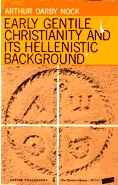 In
1928 Doctor of Divinity, A.D. Nock, a Christian writing
for other Christians in a Christian journal, put out a long essay using
this strategy. At several points Doctor of Divinity Nock's defense of
his faith turns on what seems to us an odd feature of Pagan religion:
In
1928 Doctor of Divinity, A.D. Nock, a Christian writing
for other Christians in a Christian journal, put out a long essay using
this strategy. At several points Doctor of Divinity Nock's defense of
his faith turns on what seems to us an odd feature of Pagan religion:
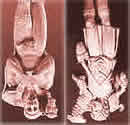 .
A few secret Pagan theologies are not provably older than the similar
Christian theologies.
.
A few secret Pagan theologies are not provably older than the similar
Christian theologies.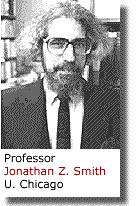 Here's
professor Jonathan Z. Smith in his famous encyclopedia article,
Dying and Rising Gods, listing four Christian sources
confirming Adonis was raised from the dead >>
Here's
professor Jonathan Z. Smith in his famous encyclopedia article,
Dying and Rising Gods, listing four Christian sources
confirming Adonis was raised from the dead >> 
 suppressed and adapting to fit in Paganism.
suppressed and adapting to fit in Paganism. ..
..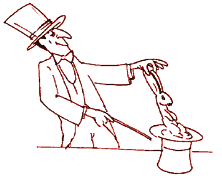

 borrowing
is impossible. The points of similarity available to TVPDSFU theory
are few: Mithras' taurobolium baptism, Adonis' resurrection, Attis'
resurrection, and a few others.
borrowing
is impossible. The points of similarity available to TVPDSFU theory
are few: Mithras' taurobolium baptism, Adonis' resurrection, Attis'
resurrection, and a few others.
 In
fact, let's talk about baptism. For the Mithraic taurobolium (salvation
by bull's blood baptism) and cribolium (lamb's blood) baptisms, the
TVPDSFU theory is that Mithras-ism—which
was completely different from Christianity—plucked
up the central sacrament of Christianity and plopped in down in the
middle of their Pagan tomfoolery.
In
fact, let's talk about baptism. For the Mithraic taurobolium (salvation
by bull's blood baptism) and cribolium (lamb's blood) baptisms, the
TVPDSFU theory is that Mithras-ism—which
was completely different from Christianity—plucked
up the central sacrament of Christianity and plopped in down in the
middle of their Pagan tomfoolery. 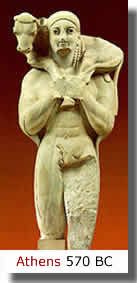 So Christianity did borrow?
So Christianity did borrow?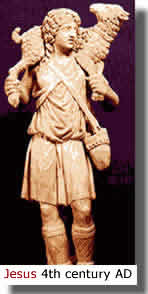 Start
with the direct evidence for Pagan borrowing. There isn't any.
The only evidence for the TVPDSFU claim, the claim that old
established Pagan religions borrowed their ideas from upstart Christianity,
is that the record about a few particular elements of a few particular
Pagan religions dates after Christianity was founded.
Start
with the direct evidence for Pagan borrowing. There isn't any.
The only evidence for the TVPDSFU claim, the claim that old
established Pagan religions borrowed their ideas from upstart Christianity,
is that the record about a few particular elements of a few particular
Pagan religions dates after Christianity was founded.  First,
no one who puts up TVPDSFU as convincing will admit Christianity
borrowed all those other things. As it is applied in the real
world, the TVPDSFU's they're similar, the second one copied
reasoning gives different answers depending on who's borrowing
is being analyzed. For Pagan borrowing TVPDSFU's
they're similar, the second one copied answers they
did, and for Christian borrowing its answer is
exactly the opposite: they didn't.
First,
no one who puts up TVPDSFU as convincing will admit Christianity
borrowed all those other things. As it is applied in the real
world, the TVPDSFU's they're similar, the second one copied
reasoning gives different answers depending on who's borrowing
is being analyzed. For Pagan borrowing TVPDSFU's
they're similar, the second one copied answers they
did, and for Christian borrowing its answer is
exactly the opposite: they didn't.
 Here's
what I mean. TVPDSUF tries to prove Christianity is unique.
But if it's they're similar, the second
one copied reasoning is true, then Christianity
did borrow all that other stuff from Paganism. That means that
generations before the Mithras-ists could borrow the taurobolium
and the Adonis-ists could borrow the resurrection of their godman,
Christianity was already Pagan. By
then Christianity had already borrowed Pagan godmen, Pagan sons
of God, Pagan miracles, Pagan initiations, Pagan virgin births,
Pagan prophesies, Pagan eternal life, etc. etc.
Here's
what I mean. TVPDSUF tries to prove Christianity is unique.
But if it's they're similar, the second
one copied reasoning is true, then Christianity
did borrow all that other stuff from Paganism. That means that
generations before the Mithras-ists could borrow the taurobolium
and the Adonis-ists could borrow the resurrection of their godman,
Christianity was already Pagan. By
then Christianity had already borrowed Pagan godmen, Pagan sons
of God, Pagan miracles, Pagan initiations, Pagan virgin births,
Pagan prophesies, Pagan eternal life, etc. etc.  And
with Christianity being generally Pagan already, it's unlikely
Paganism needed to borrow from Christianity—any more than,
say, Christianity in general has ever borrowed key doctrines
from the Amish. The TVPDSFU analysis degenerates to pure Paganism,
all that borrowing, all those ideas fading back into prehistory.
And
with Christianity being generally Pagan already, it's unlikely
Paganism needed to borrow from Christianity—any more than,
say, Christianity in general has ever borrowed key doctrines
from the Amish. The TVPDSFU analysis degenerates to pure Paganism,
all that borrowing, all those ideas fading back into prehistory. That
Jerome in the fourth century, Cyril in the fifth, or Billy Graham in
the 20th wrote about Adonis' resurrection is of course irrelevant to
the Pagan belief's dating. Origen wrote about Adonis' resurrection in
the second or early third century; the belief was certainly around by
the second and early third century.
That
Jerome in the fourth century, Cyril in the fifth, or Billy Graham in
the 20th wrote about Adonis' resurrection is of course irrelevant to
the Pagan belief's dating. Origen wrote about Adonis' resurrection in
the second or early third century; the belief was certainly around by
the second and early third century.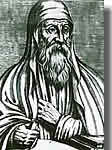

 n
this lake it is that the Egyptians represent by night his sufferings
whose
n
this lake it is that the Egyptians represent by night his sufferings
whose

 4.
Timing
4.
Timing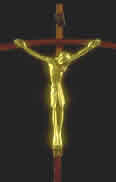 It's
impossible to be specific about what Professor Smith's theory imagines
happened because he gives no evidence that he's thought through what
happened, beyond the simple fact that Origen 185- 254 AD, mentions
Adonis' resurrection.
It's
impossible to be specific about what Professor Smith's theory imagines
happened because he gives no evidence that he's thought through what
happened, beyond the simple fact that Origen 185- 254 AD, mentions
Adonis' resurrection.  Franz
Cumont's Oriental
Religions in Roman Paganism (1911, with several later reprints)
traces the influx of middle eastern religions
Franz
Cumont's Oriental
Religions in Roman Paganism (1911, with several later reprints)
traces the influx of middle eastern religions —Isis-ism,
Cybele-ism, MIthras-ism, like that—into Rome in the first centuries
AD.
—Isis-ism,
Cybele-ism, MIthras-ism, like that—into Rome in the first centuries
AD.  2.
Christians were hated and persecuted.
2.
Christians were hated and persecuted. For
example the famous anti-Christian-borrowing scholar Walter Burkert
wrote a nice fat book about how Pagans borrowed from other Pagans,
in which his criteria for borrowing were pretty loose. As in:
"
For
example the famous anti-Christian-borrowing scholar Walter Burkert
wrote a nice fat book about how Pagans borrowed from other Pagans,
in which his criteria for borrowing were pretty loose. As in:
"